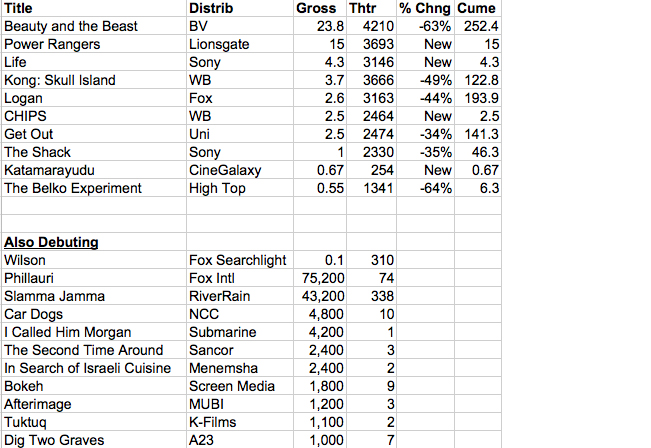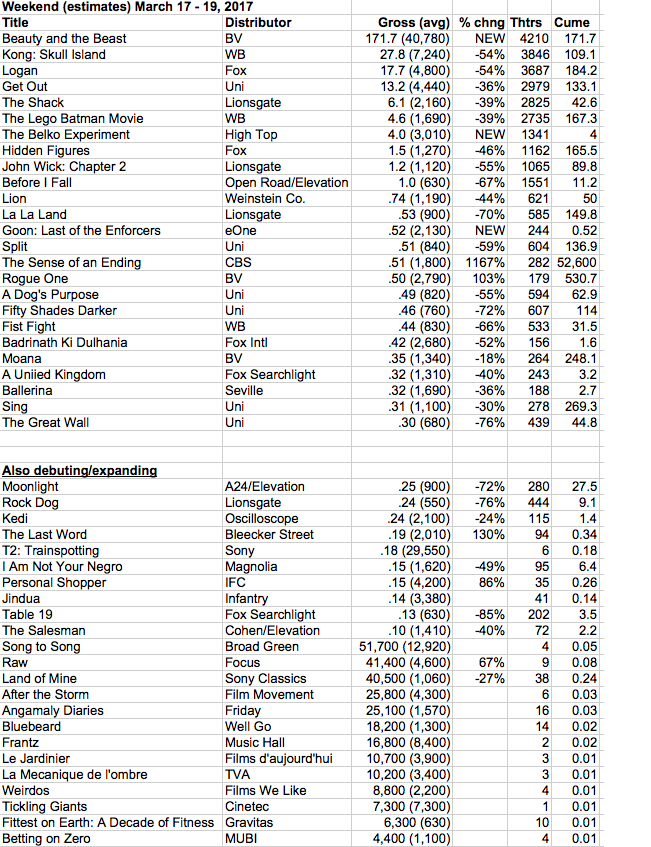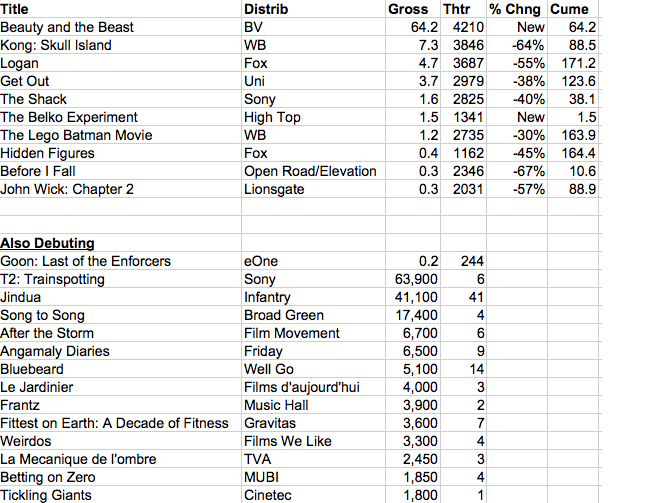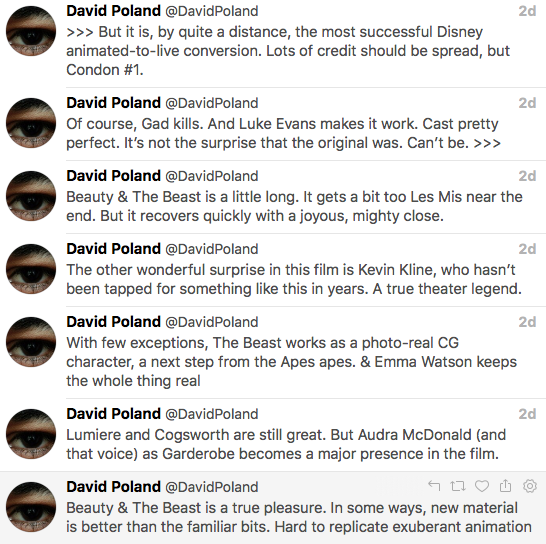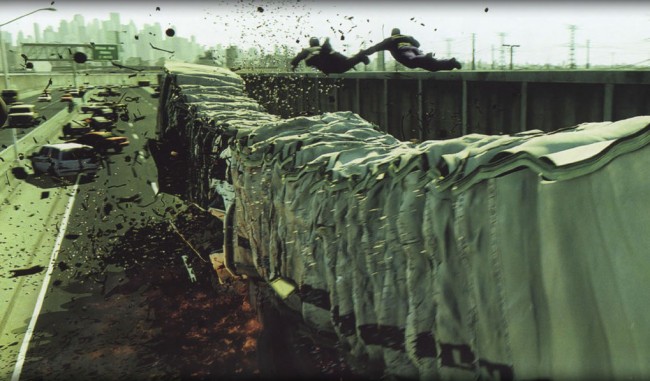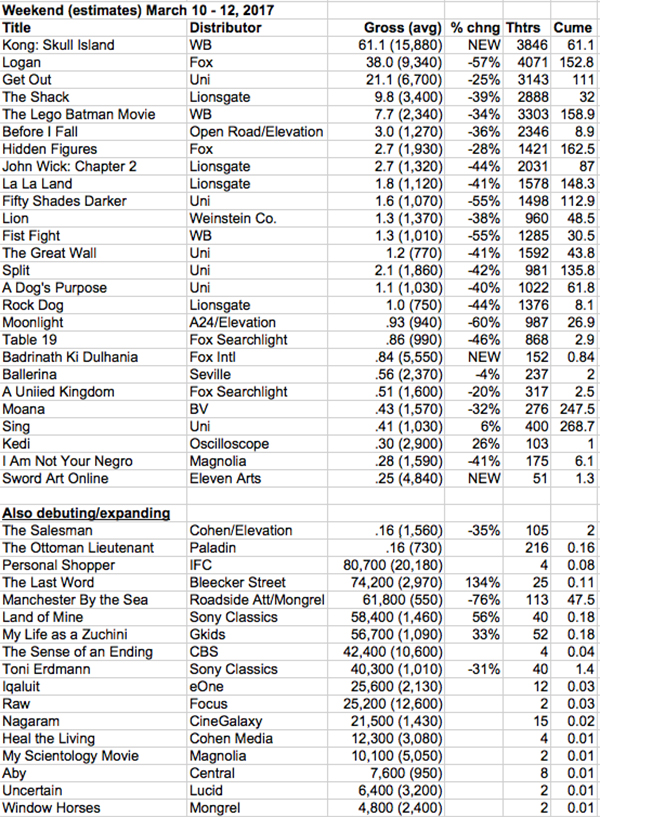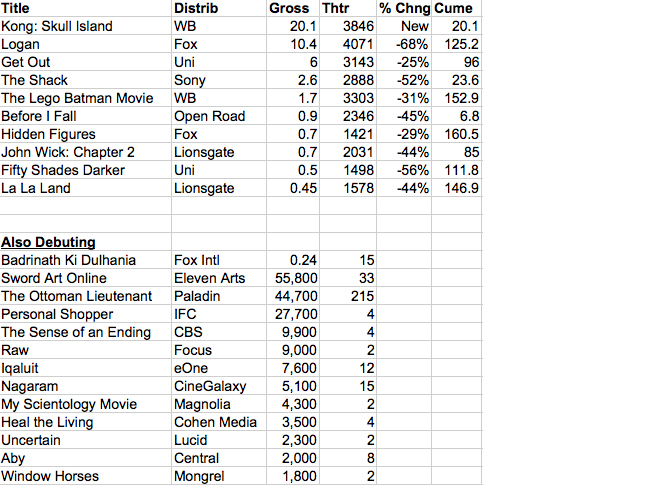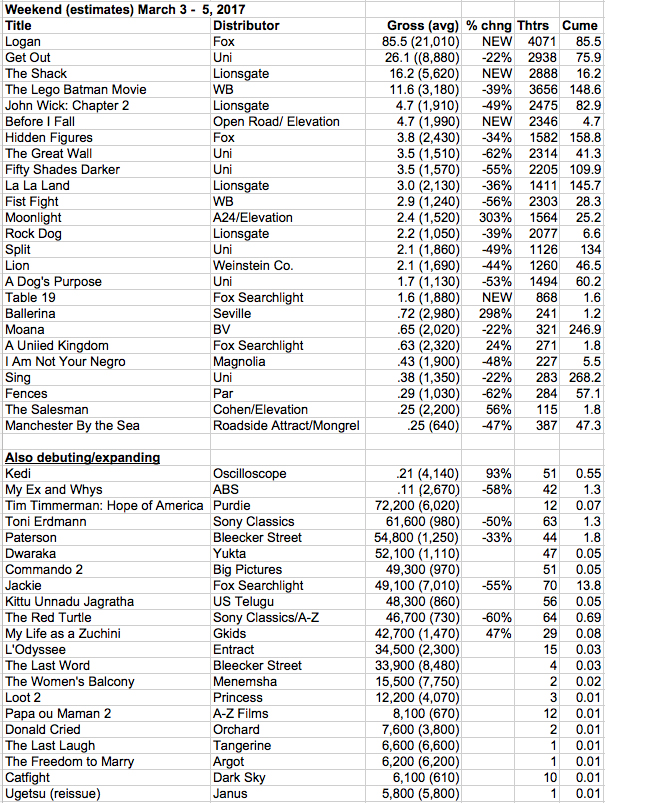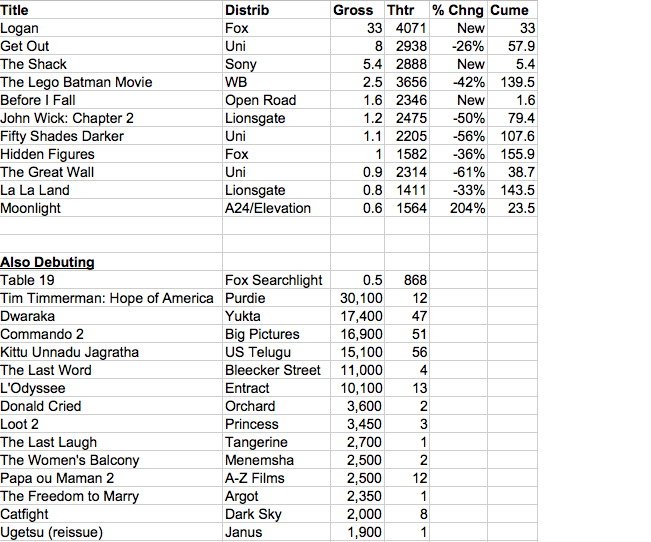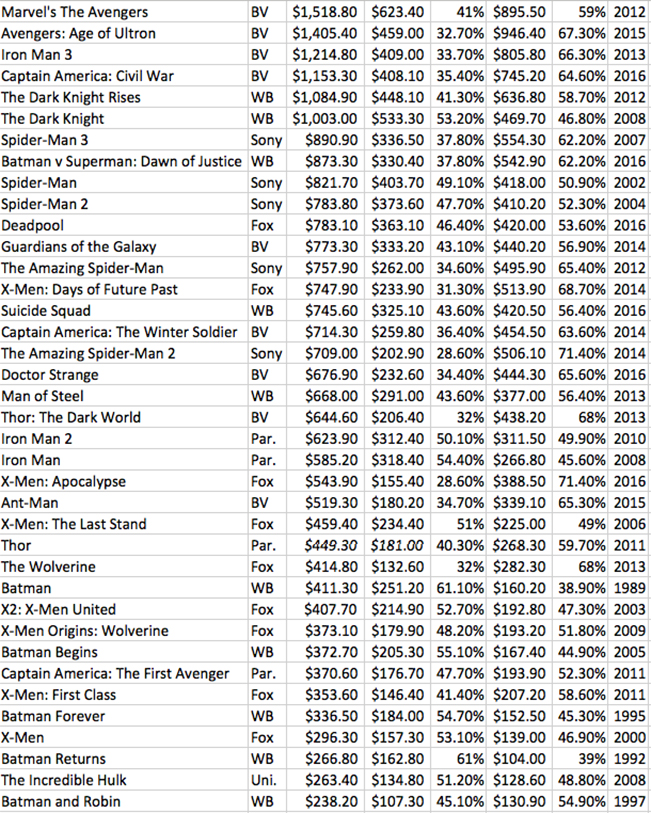The Hot Blog Archive for March, 2017
Smashing Wide-Release Theatrical Windows: Murder or Suicide?

The theatrical business is not dying.
There are no actual stats that suggest it is. Total revenue is up. Ticket sales were up for the second straight year in 2016, though there is a “new normal” since ticket sales (as we sloppily measure them) peaked in the modern era in 2002. And this is just domestic. Internationally, theatrical has been booming for years, though it is now maturing into a more certain groove.
So why do so many of the major studios seem inclined to break the infrastructure of what works?
About two-thirds of major studio releases (Disney/Fox/Paramount/Sony/Universal/Warner Bros) grossed $100 million or more worldwide in 2016. And about one-third grossed less. That one-third is what all this hullabaloo is about.
Basically, a short window would allow distributors to cut the cost of marketing flops at the next level of release, home entertainment, a dream since the days of VHS. Also, there might be some money created by easy, early availability… before the stench sinks in.
The marketing argument also speaks to the $100 million-plus grossers, but there are more variables and a lot more risk to the more successful films.
For instance, a movie like the $125 million domestic-grossing/$239m ww Sully didn’t drop under $1 million for a weekend until Weekend 8. But Inferno, which did $220 million ww but only $34 million domestically, dropped under the $1 million line in Weekend 4. WB wouldn’t want to get in the way of Sully playing strong by having it head to VOD on Weekend 6. Sony, on the other hand, was so done with Inferno after three weekends that it cut the screen count to 770 on Weekend 4.
It is all well and good to say, “Well, obviously you push Inferno to VOD as quickly as you can.” But a 6-week window for Inferno is not just a window for Inferno… it becomes an expected standard. It’s a big, major studio sequel from Ron Howard, starring Tom Hanks and Oscar-nominee Felicity Jones.
We have been through this before, as the choice of going to the movies became, “Do I need to go or wait for the rental?” Then it became, “Do I need to go or buy it for $9.99 at the grocery store?” Now, it’s “Do I need to go or can I wait for it to stream?”
How the studios treat their content becomes an object lesson for consumers. When you saw piles of DVDs in the discount bin for $5.99, the brand new Blu-ray with all the bells and whistles somehow doesn’t seem worth $24.95 (or more), even if the Blu is your biggest hit movie and the stuff in the bin is 7 years old. When you put three Oscar-winners in a package for $9.99, you are telling the consumer that your films have little value.
And the sales of DVD, then Blu-ray, confirm this position.
So what are distributors pushing for shorter windows using to bolster their faith that shorter windows won’t discourage spending in theatrical?
I don’t know that they have an argument. They just shift the conversation to the wider margins on VOD over theatrical exhibition. That difference will, they seem to think, not only make up for the theatrical losses, but to create greater profits.
And it could, I guess… if the same number of VOD units were being sold as theatrical tickets. But as far as I know, no film has ever, over any amount of time, sold as many as 15 million VOD units. And almost 20 million people went to go see Beauty & The Beast in the US alone two weekends ago.
Shift the conversation again… charge “fight prices” for the early VOD of movies. $50. $30. Profits are even greater.
Let’s not even get into how many people might watch the pricey VOD showing in the same room at the same time. (There is a company out there pushing a camera that will scan the room to see how many people are watching and charge accordingly… all the invasive discomfort of the mall, now in your home.) Let’s just have a pricing conversation.
You can do as many surveys as you like. People who make $250k+ a year will buy almost anything without sticker shock. You can get them. But Average Ticketbuyer, now paying $85 for 300 channels and another $10 a month for Netflix? Are they really going to spend when they pay for half a month of endless amounts of filmed entertainment to watch one movie at home that will expire in 48 hours or less?
Media loves talking about the Netflix threat. The threat isn’t that they will so dominate the marketplace. The threat is that a $10 price point for that amount of content sets a low enough bar that it not only makes $30 for one showing of one movie seem silly, it has actually kept the studios from moving forward towards the real future, which is a much more densely competitive streaming environment. (Another column.)
SHIFT! It doesn’t matter whether Average Ticketbuyer is willing to do. Short-window VOD will expand the size of the audience.
Will it? This is the easiest debunk in the game.
There are roughly 350 million people in North America.
Half the tickets sold to movies are sold to 27 million of those people, aka Frequent Moviegoers (12x a year or more).
The other half of the tickets sold are to people who go tot he movies about 3 times a year, aka Occasional Moviegoers. They number about 175 million people.
About 5 million people say they go once a year.
That leaves about 145 million North Americans who NEVER pay to see a movie in a theater.
Is there any reason to believe that another of those 145 million people are suddenly going to start buying high-dollar VOD so they can see a film a couple months earlier? Or the 5 million who go once a year?
How about the 175 million Occasionals? Well, they spend an average of about $27 a year going to the movies. So how much are they going to spend to watch a movie at home? It is true that some of those 175 million people are seeing movies 10 times a year… or 8… but also, some see 2 or 3. MPAA & NATO haven’t made those detailed stats available.
Let’s be generous and say 20% of the Occasionals are on the high end and perhaps more open to high-ticket VOD. 35 million. And the 27 million Frequents.
So realistically, the market, at best, starts with 62 million North Americans. 18%
Is Netflix the competition? They have about 43% of North American households subscribed and those subscribers currently spend more for the service than all but 27 million North Americans (The Frequents).
And forget about Cable/Satellite? Over 90% of households. And at a price greater than 100 movie tickets bought annually.
Studios have convinced themselves that there is a bigger VOD market than they already have, driven by shorter windows. But it’s not realistic that they will, with higher prices and shorter windows, expand the share of people for spending on the individual purchase of access to movies. The expansion of revenues will have to come from the small market that already spends money to this end.
By the way, you can tell me about the surveys that say people want day-n-date at home. They do. But at what price? And is there a real openness to the higher price point the month after the first bill arrives? History says, “no.”
So let’s look at the, say, 35 million North Americans who are the legitimate targets of this effort. Then, let’s cut that number in half, assuming that at $30 or $50, at least 2 people who might otherwise go to the movies, will watch at home together. 17.5 million. $30 a viewing. $535 million. Let’s say that they do this 4 times a year. $2 billion!!!
Now deduct the $1.26 billion that the same group, who have already shown a willingness to go to theaters and pay for movies, would have spent seeing those movies in theaters. Still… $750 million!!!
And let’s say that the distributors get 85% of the gross (very generous). $640 million!
And let’s add the 30% that they wouldn’t have gotten from the theatrical ticket sales we took away two paragraphs ago. Add that $380 million and the “new” revenue is now just over $1 billion.
Oh wait! Distributors are claiming that want to share 10% of this business with exhibitors (aka The Carrot). $200 million. Now we’re down to $800 million in a scenario that is extremely generous to the whole project, given the history of PPV and VOD.
$800 million ain’t nothing.
But then… look at the potential cost of adding 3% – 5% to the overall movie revenue stream.
If it worked this well, one has to assume there is some cannibalization, even with the focus on Frequent Moviegoers. Four times a year wouldn’t likely lead to cannibalism of 1/3 of the Frequent Moviegoer (at least 12 a year) market. But 20% wouldn’t seem unlikely. And those moviegoers are half the market, so a 10% cut in the market to exhibition.
What does that mean? Broadest strokes, a company like AMC, which netted just over $100 million on revenues of just over $3.2 billion would take a $300 million hit. So even with, say, $120 million in savings on film rentals and food costs, this would turn the company’s net gain into a net loss.
Does that exhibitor keep expanding and remodeling regularly if they are operating at a loss? They can only save on rent ($500m annually) if they shut down theaters (though they have long leases that make this hard).
Theaters continue to operate, unimproved. This drives more people towards VOD. And eventually, you get what happened twice in the last 38 post-DVD-sell-thru years? Well-considered bankruptcies and a reconfiguration of what the theatrical market looks like.
But in the next generation of reconfiguration, the screen count gets smaller again, as exhibition is forced to focus more closely on event films, where there is still an intense, short-window hit. And then there aren’t enough screens to support a “middle class” (or lower class) of studio films.
We’re not quite done. This is where it gets scary.
This may be what the studios, now small parts of massive corporations (except Disney and Paramount), want to see happen.
The top 26 studios movies in 2016 generated about 2/3 of all the box office revenue created by American-distributed movies, all the grossers of over $300 million. The only film that was not a sequel, part of a franchise or a brand (like Illumination, DWA or Disney Animation) was The Mermaid, a Stephen Chow film (which is a brand in Asia), which grossed just $3.2 million domestically.
The 71 other releases by major studios generated less than half of what those top 26 films grossed theatrically. Some were highly profitable. Some lost quite a bit. Only 12 of those 71 were sequels or wannabe franchises. Only Ghostbusters, Assassin’s Creed and The Huntsman: Winter’s War were big scale movies.
What makes this especially scary is that the old saw used to be (ht to Peter Guber) was, “Why don’t you just make the good ones?.” Now, you can really separate the top of the box office from the rest.
There is still downside. I would estimate that 5 of those Top 26 lost money in spite of grossing over $300m worldwide. And the cost of production on most of the Top 26 is much, much higher (on average) than the second tier of 71. But the cost of marketing is not.
As greedy as multinationals are, they are equally risk averse. They want to able to predict what is coming. And if what is coming is 4-6 big budget, nearly-guaranteed mega-movies and everything else is, quite literally, TV, they might well take that deal. Smaller companies. Down and dirty. Hire on freelancers as needed to ramp up a release every two months or so.
Releasing Silence, Florence Foster Jenkins, Zoolander 2, Fences, 13 Hours: The Secret Soldiers of Benghazi, Ben-Hur, 10 Cloverfeld Lane, Office Christmas Party, Allied, Jack Reacher: Out of the Shadows, Arrival, and Teenage Mutant Ninja Turtles: Out of the Shadows is hard work… and expensive… and not all that profitable. The thinking of a corporation is, why bother? At least 4 of these films have loving, loyal, passionate audiences. But, financially… why spend all that energy?
And if that is the case… distributors are not foolishly chasing new revenue, but are consciously aware that sipping the Kool-Aid may lead to the death of a significant portion of this industry.
Can you make Florence Foster Jenkins or 10 Cloverfield Lane or Office Christmas Party for $10 million and stream them on what will be one of the 10 top streaming networks in a few years? Yeah. Probably. But the rest just disappear, because the idea of Netflix or any future streamer making a bunch of $40 million and $70 million movies (or pricier) and surviving is a fantasy. There is no business plan in which that makes sense long term.
I don’t mean to be picking on Paramount. The same is true everywhere… except Disney, where they are already close to giving up on anything that isn’t uber-IP.
So maybe I need to stop whining and just deal with reality. If they want to kill the industry – or shrink it by half – they are on a good track. They just want to be in a different business.
I think there will be enormous regret, especially when the long tail really stretches out and we can access virtually every piece of filmed entertainment ever made at a low price (likely by subscription, not unlike cable packages).
Maybe there will be a “rebuild the movie palaces” movement. Or maybe we will all just have to get a bigger TV or goggles to make it feel more immersive… all without much human contact. Evolution… in the Twilight Zone.
5 Comments »Weekend Estimates by Power Deranger Klady
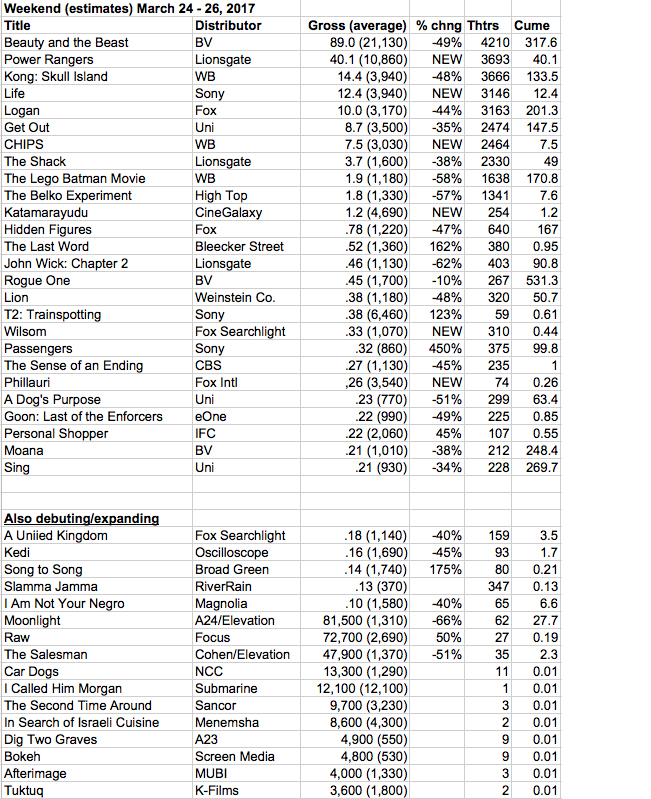
.
There is nothing ugly about Beauty & The Beast & The Box Office. Based on the international estimates, $690m worldwide after its 2nd weekend. Power Rangers did well for itself, not getting a big Saturday bump, but not suffering a major drop-off after Friday must-sees. Next weekend will be interesting. Life is getting lots of “it’s not so bad” comments from first-weekenders, though not passionately enough to overcome this weak opening. And CHIPs was exposed as a dirty unit without a pair.
There are now twenty-eight $1 billion-plus worldwide movies at the box office. #29 is one the way.
What is hard for analysts in looking at Beauty & The Beast is to figure out the “why.” Is this just the strongest Classic Disney IP? Is it the ways Bill Condon stuck to the original, or the ways he broke free? Is Emma Watson a key element or just one of many young actresses who could have done quality work? How important is the multigenerational aspect? Would it have happened without Frozen? Etc, etc, etc.
The reality is, we will never know how this stew cooked into a smash that will likely pass $1 billion worldwide before the end of Weekend #4 (maybe even at the end of Weekend #3). This is equally true of great success, great failure and all that is in the middle. We often convince ourselves of one idea or another. But we don’t really know. There are just too many variables.
One of the biggest confusions that comes with a movie like B&TB is that the numbers come in so quickly. As I have long written, opening weekend isn’t about the movie itself. The hold the second weekend is much more significant. When a movie does $400 million over 17 days then does $100m in the rest of the run… what does that mean? Only 7 movies have ever done more than $500m domestic. So is that just the saturation point? Or does the fall-off suggest a flaw?
It may seem extreme at such a high set of numbers. But if you watch box office closely, you see much of the same phenomena through all levels of grosses (in most cases). Opening weekend really does determine the life of almost every movie. There are variations in every case, but ultimately. there doesn’t tend to be much in the way of surprises after the opening.
Perhaps the industry would be better served trying to figure that out – both in success and failure – instead of trying to throw the baby out with the bathwater with day-n-date or anything that breaks the windows further. Personally, I believe that if the industry made steps to support and grow theatrical for films that do get a foothold on opening weekend, exhibition would eventually be willing to make concessions that would speed the cycle for films that fail, maximizing those opportunities. But as long as history tells exhibition that a foot in the door will lead to the door being kicked down without a lot of thought, they will fight for their lives… because they really have to.
Power Rangers. Legit nostalgia-driven success. People seem to like the movie. As noted yesterday, did they like it because of expensive effects? Not from what I hear. I gather that when the rangers line up, like in the TV show, there is a cheer. That is the money. I’m not saying they should have gone 1960s-Godzilla cheap. But that is what made the show go and is a big part of what people love. Looks like Saban will make good money on this reboot of his old show with The Breakfast Club, but he could have made more. Unlike him to spend into an idea. But a win is a win.
Kong: Skull Island is not a big hit… but it isn’t the disaster it should have been… er, it looked like when it opened. The film is hovering below breakeven now and could cross that mark, depending on international.
Life is on life support. But like so many movies these days, it could be saved and even made into a profit center with international. It depends on how real the budget is vs the reporting. Anything less than $100m international isn’t gonna cut it.
Logan passes $200 million domestic. $565m worldwide. In the money already. James Mangold becomes a go-to-action director on every studio list. More importantly, his vision is now more valued by those studios. Stacey Snider’s future at Fox will be defined, in no small part, by how she reboots X-Men.
Get Out is still going strong… a rare word-of-mouth acceleration. The comparison I see is The Sixth Sense. A word-of-mouth smash that your friends don’t want to ruin for you.
CHIPS crapped its jodhpurs. But as noted yesterday… BUDGET. Why did this thing cost $25m+? If it was made, like Get Out, for $5 million… or even the $15m range of a Hot Rod or a Let’s Be Cops… it would be fine. What were they thinking?
Wilson arrived on 300 screens… and with a $1,070 per-screen, don’t expect to see it on more screens before it fades away and heads to Home Entertainment.
IFC has to be frustrated with Personal Shopper. It’s tracking right along Certain Women, which eventually got to $1 million. Personal Shopper might too. They actually got to $1.9 million for Clouds of Sils Maria, but the Kristen Stewart business seems to be getting harder instead of easier… even though she is finally getting her due as an actress.
Moonlight has earned almost $6 million domestically since it won Best Picture, pulling it out of the bottom slot among Best Picture nominees. with $27.7 million. It has also become the #1 grosser in the history of A24. Impressive.
45 Comments »Friday Estimates by Still Beautiful Klady
Beauty is a box office beast. Number four second weekend of all time. Should get close to (or could pass) $700m worldwide by the end of the weekend. $1 billion is looking easy.
How can you f-up Power Rangers? You could spend $100 million making a feature film based on one of the cheesily-produced franchises ever, even without hiring a major box office star to show their face in the thing. That said, it may not be a disaster. $37m seems likely this weekend, although there could be a bigger audience on Saturday, pushing that number some. And international… who knows? The film could be profitable, though I don’t think there is a dime being made on anything they spent on production over $40 million. No one cares. It’s a Power Rangers movie.
Life is unwell. Sony has now gone six months without an opening going over $15 million. (Notably, Passengers didn’t catch up internationally and although not a massive money loser, means red ink for Sony.) And Smurfs: Lost Village isn’t a sure bet to break that rough streak. Smurfs 2 opened to just $17.5m, a drop in half from the first in the Sony series. That takes Sony to June and the Scarlett Johansson/Kate McKinnon comedy, Rough Night, which I think will open over $15m and then the new Spidey, which is a guaranteed opener. But then Sony is in the danger zone again with Dark Tower, which could be a big hit… or a career-crushing flop. After that, Sony has some movies that may be good, but nothing that looks particularly commercial until Jumanji, which isn’t until next Christmas. Oy.
Audiences clearly aren’t convinced that they needed to see a spin on Alien a few months before the real thing returns (again). Ryan Reynolds is a box office superstar in a red suit, but not out of it. And Daniel Espinosa is looking like the example that people point to when saying men get a lot of chances in the studio directing chair after failing when women can’t get going (he had two barely released films between this and his one hit, via Denzel, Safe House).
Still, the Life opening makes the CHIPS opening look pretty good. This film should have been made under the Let’s Be Cops rules… cheap and fast. But instead, WB spent a reported $25 million. Yeah… that’s not expensive… but not cheap enough. You want to take a flyer on Dax Shepard’s idea for an IP play on an old TV show? Given him $10m max and let him have fun. I haven’t even seen the film, but I can’t even imagine how he spent $25 million. Maybe a lot of that is studio overhead… but it’s still bloated. Universal and Jason Blum can make $5 million movies. Why can’t WB?
Did you know Wilson opened this weekend? I love the thing and didn’t know it was opening, or I would have told you to go see it. It’s not Ghost World. In some ways, it’s even further down the rabbit hole… a movie around the guy who is sitting on that bus bench. But still, great Daniel Clowes stuff. It’ll get a cult audience down the line, on cable/satellite/VOD/streaming.
17 Comments »Weekend Estimates by Kladysworth
Be our ticket buyers, be out ticket buyers, put our movie to the test. Buy 15 million tickets plus, and Disney does the rest. Potter girl, CG beast, why, the song count has increased! Set some records, mock the shouters, don’t believe them, ask bean counters!
And most interesting of all, the big number for Beauty & The Beast didn’t get in the way of pretty decent holds for the big, more adult action stuff that was already doing business, suggesting (however unintentionally) that some balance in the market can actually work.
The biggest opening of all time without a Marvel character or a dinosaur. It’s pretty amazing.
You can’t really qualify it as an original, as it uses the materials of a hit film. In an odd way, it shares commercial DNA with Jurassic World, which used none of the original characters… except for the one “classic” dino. (SPOILER ALERT TOO LATE!) You know, there were more than 5 Disney-made Beauty & The Beast psuedo-sequels featuring the voices of Paige O’Hara and Robby Benson that were released on video (not to mention a Broadway musical) over the 26 years between the original and now. Unless you have kids the right age, you probably heard of none of them. But they kept the heartbeat alive, much as the Jurassic sequels did. And of course, there have been many other versions of the classic public domain story over the same 26 years.
Still, studios bet on IP that seems to have staying power all the time and rarely does anything hit the way this film is hitting. It begs the Frozen 2 issue… can the next set of songs be as compelling as the first set of songs? Jim Cameron’s challenge on Avatar 2-4 isn’t just continuing the story effectively, but capturing the sense of the new that the first film did for more than a hundred million people.
Of course, this opening weekend is (wait for it) not… about… the… movie. Never is. It is about what people are anticipating about the movie based on ads and publicity. Audiences clearly wanted this “revival” to happen and animation set in live action is really the variation on the original that makes it safe to revisit. Bill Condon has also taken the film to places that are uniquely in his skill set and brought some new twists. Most difficult, I think, was trying to infuse the literal nature of live action cinema with the magic that existing in the animated version. Mostly, he succeeded… not by imitating, but by finding a paradigm that fit his film first and then paid homage to the original.
So… $172 million domestic. The worst performance by a $150m+ opener (there are only 10) was $330m by Batman v Superman. But $400m domestic seems like the absolute bottom for B&TB. The film did $180m internationally this week, in 44 markets, including China. $500 million seems like the bottom there. So, a billion is well within range. Topping Alice in Wonderland‘s $1.03b record for Disney adaptations is a distinct possibility, if not a probability.
Meanwhile…
Kong: Skull Island, a terrible piece of junk, didn’t die an ignoble 2nd weekend death. 54% is pretty respectable, given a strong launch and the genre element. Warner Bros. should be happy with this result, though the film is still in danger of being a money loser for Legendary.
Logan, the hard-R X-Men movie that probably signals the end of the current generation of X-actors, is still hanging tight, heading past the $200m domestic mark next weekend, already past $500m worldwide. Big victory for people who like good movies, even when they are genre.
Likewise, Get Out had a 36% hold in weekend 4. Wow. Should pass Split on Thursday as Jason Blum’s biggest film ever domestically, though it has a lot of work to do overseas to catch up with Split‘s $120m or so.
I guess we are supposed to be talking about how theatrical needs to transform in 2017… not good enough anymore… no one wants to go to the movies…
Ha.
The “Oscar bump” for Moonlight is pretty much over. A24 has the film on 280 screens and those screens averaged less than 10 people per screening this weekend. The Best Picture winner has been on DVD and streaming for 3 weeks already, so there is no shame or surprise in this. If you haven’t seen it on a big screen, go.
La La Land is now over $425m worldwide. Hidden Figures is at $215m. Arrival, $198m. Hacksaw Ridge, $175m. Lion, $122m. So for everyone who thought this was a weak year commercially for Oscar movies.. surprise.
The Salesman, the Oscar-winner for Foreign Language, added another $100k to get to $2.2 million. I Am Not Your Negro, which didn’t win Best Documentary, is winning in the theatrical release category, now at an amazing $6.4 million. It’s not quite as big as last year’s Amy, but outside of Disney Nature, IMAX, and Democrat-bashing, it is at the very top of the charts over these last 5 years.Successful doc releases like the Ron Howard Beatles doc, Michael Moore’s 2016 film, and The Eagle Huntress just didn’t come close.
T2: Trainspotting manages $29,500 per screen on 6… which will earn it some more screens… but don’t expect too much. Sony doesn’t seem to want to spend too much to get this one on its feet.
Song To Song, the latest from Malick, manages $13k per on 4, which is not going to get it much of an expansion. This may be one of his best films to watch on your big screen at home in a while.
15 Comments »Friday Estimates by Klady & The Klady
Batman v Superman: Dawn of Justice. Furious 7. The Hunger Games. Beauty & The Beast.
These are the four biggest openings outside of the Summer or Holiday periods. Ever.
Which of these things doesn’t go with the others?
Why, that would be the family movie that plays to both young and old. Of course, the traditional box office modeling for a family film gets twisted by the big opening day. So 3x+ opening day, with a massive Saturday compared to Friday, seems unlikely. But we still have to account for that possibility. on the other side of the coin, there was a clear niche for Hunger Games and an age bottom for the other two, so using them as comps seems wrong.
Even using Bill Condon’s biggest opening before this, The Twilight Saga: Breaking Dawn Part 2, is futile, as that franchise was so intensely niched out. The opening day was actually larger than Beauty‘s… but the weekend couldn’t even double it, much less triple it, as family films often do.
In other words, B&TB will set its own standard as a box office placeholder on opening weekend. Could be $140m… could be $175m. No one knows (although someone at Disney is looking hard at matinees on the east coast right now, wondering if the snow helps or hurts).
Meanwhile, critic schizophrenia is showing up earlier in the year, as many critics gave a pass to the shambolic Kong: Skull Island, which is nothing more than a rancid smorgasbord of action movie cliches held together with indifference, while ripping into Beauty & The Beast for not being original enough and being part of a financial strategy at Disney.
1. Review the movie, not the studio. 2. Be a little consistent. That is all I ask. (And to those of you critics who were… thank you. I didn’t mean you.)
It’s interesting. Beauty will be the seventh different #1 at the box office in the 11 weeks since the first of the year. And critics have been able to feel like they matter, with all six of the other top dogs being “Fresh” with over 75% at RT, including Split and Kong: Skull Island, but also happy surprises like Get Out and Logan. Beauty looks like it will be the lowest ranked among the 7, almost like critics got to the saturation point of being comfortable with being in sync with the public. To be fair, Logan and Get Out were (and are) films that knock the chip off a critic’s shoulder. And Beauty & The Beast is not perfect by any means. It certainly is not loaded with the wildly unexpected. But reading some reviews in major papers, they felt written before even seeing the movie. The Disney machine is a trigger. And I fear that Ghost in the Shell, if it isn’t a delightful surprise, will be slaughtered in a dramatic bloodbath. (Of course, it could deserve a bloody death. The more of the movie that is shown in the ads, the more troubled it looks.) Who knows what’s in store for The Fate of the Furious? (I’m betting it will get a pass.)
Back to box office… I suspect that not only will Beauty be #1 again next weekend, but that the three wide releases will all have the crap kicked out of them, business-wise. “It’s a trap!” I’d be happy to be wrong, especially for Life. But I have a feeling that all three movies are in harms way and that no one is really excited for any of them to arrive (no matter how many billboards Power Rangers has in L.A.).
Kong: Skull Island had a reasonable 1st-Friday-to-2nd-Friday drop and will squeak by $100m this weekend.
Logan is showing signs of age, but will pass the domestic on X-Men Origins: Wolverine this weekend.
Get Out is now chasing only this year’s Split for the top grossing domestic slot in Jason Blum’s career. It will pass Split next weekend.
The Belko Experiment opened.
John Wick 2 hasn’t quite doubled John Wick yet, but it’s coming… as is John Wick 3.
T2: Trainspotting was dumped by Sony and now they will rationalize the choice with this opening of their creation. About $30k per-screen for the weekend, but on just 6 screens. This will get the film to 80+something screens, probably… but not further. Unfortunate.
The new Malick, Song to Song, will do about $11k per screen over the weekend, despite massive star power. Oddly, the film will play better on TV, where you will be able to get distracted for a bit and not really mind, as you will come back to some wonderful moment of art and acting before you get distracted again for a bit. There is so much to love in this film… and so much of this film…
22 Comments »Weekend Estimates by Monkeying Around Klady
Friday Estimates by Klady: Box Office Island
Weekend Estimates by Kladyrine
I’m interested in 1974 this weekend. Here are the top grossers that year (according to Box Office Mojo).
Blazing Saddles, the #1 movie that year, opened on February 7. And only 3 of the 12 Top grossers on this chart opened in the summer that Nixon resigned. None of the Top 6 opened in the summer (#6 was The Longest Yard, which opened Labor Day Weekend.) Benji was the top summer movie, grossing just under $40 million.
Death Wish was the #1 movie in America the weekend before Nixon’s resignation and the weekend after Nixon’s resignation. The film owned the second highest grossing weekend of the year (just under $7 million) behind only The Godfather, Part II (just over $7m). There was no noticeable box office drop (or rise) caused by the resignation of the president.
For the record, I doubt the reported total domestic gross of $22 million, given that the four weekends for which there are reporting add up to $20.6 million in four weekends, the last of which grossed $3.9m… and given the longer runs of the period, hard to see how the film grossed less than $30m domestic. Another note on the suspicion with which we should be looking at old box office stats.
Blazing Saddles was in its third weekend at #1 on this weekend in 1974. And Nixon was named as an unindicted co-conspirator in an indictment against seven former presidential aides.
Now… as for this weekend…
Moonlight didn’t get a big Oscar bump with a $2.4m gross, but this will be its biggest grossing weekend, adding more than 20% to the film’s overall domestic gross.
Logan did great. The estimate is kinda funny, as it slides right in between X-Men Origins: Wolverine and X2: X-Men United. It’s probably above or below them both. But that is the magic of Sunday.
Get Out doesn’t quite get to the teens for its second weekend drop, but close. It will become the #4 Jason Blum movie ever (domestically) and will surely be the #2… or even #1, as it chases Blum’s current career best, this year’s Split. I am particularly impressed by the current run by Blum at Universal. It’s an amazing story which seemed to be losing steam. But this year, he and his team and filmmakers have found the zeitgeist and exploded (in a good way) again.
The Shack outdid all of the “Christian movies” of the last couple years with this opening. This is Lionsgate’s first shot at one of these and it did well in context. God bless.
Open Road couldn’t find the teen girls to follow Zoey Deutsch into its quirky romantic thriller. The difficulty I had coming up with a way to describe it in that sentence explains why.
Searchlight excreted Table 19… they were clearly happy to see it go. Wilson is coming next and is quirky and challenging and may not do much box office, but everyone will be proud to be associated with that one.
Not much to get excited about in the limited/exclusive market.
27 Comments »Friday Estimates by Wolverined Klady
A $47 million Friday last February for Fox’s biggest Marvel opening ever. $33 million yesterday for what will be Fox’s #3 or #4 best Marvel opening ever and probably Wolverine’s best.
FUCK!
Apologies if that offended your eyes, but that is what these two openings have in common. That and a lot of blood. Hard-R movies.
This is the side of Marvel that Disney is not likely to ever embrace. If Disney does, that will be a huge story, not just about Marvel, but about the Disney company. But if things start to slide at Marvel as the current leaders of the franchises – read: Downey – finally age out and stop doing these characters and/or Feige leaves and numbers drop, all bets are off.
In many ways, this is the tack that Warner Bros has taken with Zack Snyder and the DC films… but like The Wolverine (the lowest grossing X-Men movie), they have tried to do it at a PG-13 level. Could that change at WB?
The numbers suggest that the Avengers films and Nolan’s Batman films are the exception to the rule in the comic book adaptation world. There are six billion-dollar-worldwide comic book movies to date. Four Iron Man/Avengers and two Batman. After that, there are only three $800m ww comic book movies, two Spider-Man and Batman v Superman.
The question is whether there is a strategy that will make the rest of the pack stronger… or for that matter, weaker. In the last 4 years and 3 months, there have been 19 big comic book movies. There are 6 above $800 million. Among the other 13, the low has been The Wolverine ($415m) and the high has been Deadpool with $784m. Within that range of grosses, there are movies like Ant-Man ($519m) that are considered hits and movies like The Amazing Spider-Man ($758m) that are considered misses.
As usual, it is impossible to make broad statements about what measure success has in the movie business, aside from the broadest (“$0 box office sucks, over $1 billion is a hit”). Would any of the dark-hearted Zack Snyder DC Extended Universe films have done more business as hard-Rs? Or would they have lost enough family business to make it a net loss? Suicide Squad? Is the “answer” to The Fantastic Four to make a hard-R version where we could learn how Ben Grimm and Alicia get down to “it,” and brings to life a Marvel version of the old DC joke about Superman and Wonder Woman’s invisible plane?
I don’t see any benefit to Ant-Man or Doctor Strange or Spider-Man or even Guardians of the Galaxy going hard-R. The Avengers too. But it is really easy to imagine a nasty, brutal, sexual Batman spin-off project. Would it hurt the brand? That is what will keep it from happening. Anyway… more questions than answers.
Excellent drop for Get Out, the must-see word-of-mouth holdover. Could be in the teens for the weekend.
The Shack is a religious movie, apparently. Likely budgeted for direct-to-DVD/streaming, so a nice number.
Before I Fall found a few teen girls, but not a great start.
The Oscar BP contenders remain Hidden Figures, La La Land, Moonlight, though Moonlight is getting a bump of a few million dollars and a load of new screens after the win.
17 Comments »




